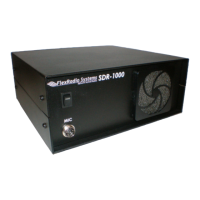3
Hardware Configuration
Standard Configuration
High Performance Receiver Preamplifier
The receiver front end incorporates a Sirenza Microdevices SGA-6286 SiGe HBT MMIC amplifier with a
noise figure of less than 2dB. With the INA baseband gain of the SDR-1000 set to 26dB, the overall
receiver noise figure is approximately 4dB. The TRX board also allows 0dB INA gain setting for large
signal handling capability. A 10dB fixed attenuator may be switched in front of the LNA to increase IP3
when needed. Overall there are four gain settings done in hardware to allow you to optimize the front end
for your needs.
The front end of the SDR-1000, provides the following key benefits:
Lower receiver noise figure
Reduces relative strength of DDS local oscillator spurs in relation to the signal of interest
Lowers local oscillator radiation in relation to the signal of interest
Fixed source/load impedance for the filters
Fixed source impedance for the QSD (Quadrature Sampling Detector, IQ Mixer)
Fifth Order Low Pass Filters
Nine 5th order low pass filter banks are provided to cover all amateur bands from 160M-6M. Since the
filters are low pass, general coverage reception is still provided. The filters improve 3rd harmonic rejection
by more than 35dB over the original SDR-1000. There are BPF filters in front of the preamp board (in the
signal chain) to provide overload protection for the LNA. The LNA is then followed by the low pass filters,
which in turn drive the QSD (mixer) on the TRX board. A spare filter bank is provided for user
configuration to allow improved coverage on other bands such as medium wave or VLF bands. While the
SDR-1000 covers frequencies down to 11kHz, additional filtering is required to minimize response to odd
order harmonics. The optional filter bank allows the user to customize the radio to add support for such
frequencies.
3 FlexRadio Systems
Chapter
3

